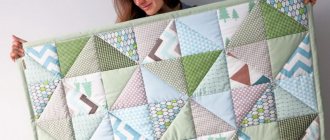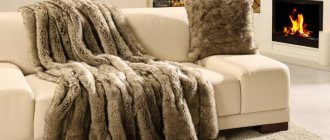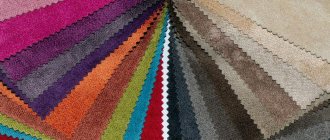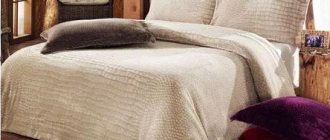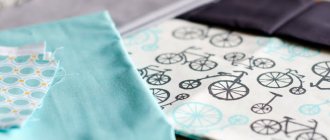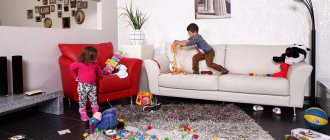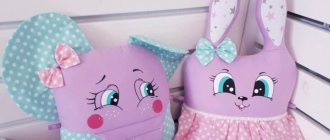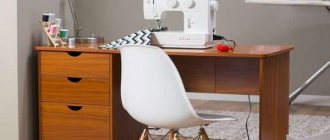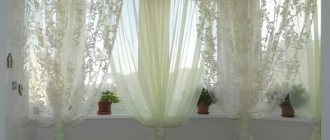Used upholstered furniture, as a rule, loses not so much its functional qualities as its appearance. Indeed, modern high-quality fillings can not wear out for years, but furniture upholstery can suffer many sad accidents that will make the housewife greatly regret that she did not bother to sew a suitable bedspread in advance. Modern stores offer a large selection of covers for upholstered furniture, but even among such a variety it can be difficult to choose the perfect item. Therefore, it is best to try to sew a blanket for the sofa with your own hands. To do this, you will need suitable fabric, a pattern (especially if you are preparing to make a bedspread for a corner sofa) and a little patience.
Functional Features
When making a textile item, you need to immediately determine what and why it is needed. The thing performs several functions at once, which are of great importance in their field:
- The sofa upholstery is protected from mechanical and other damage.
- Does not allow dirt to penetrate into factory upholstery.
- Decorative. A handmade product will be unique and add an atmosphere of comfort and individuality.
- An additional feature of the model may be the presence of a blanket.
Functionality
You can come up with a few more elements that will make the thing more original. You can sew small pockets to the sides of the cover. Here you can store the TV remote control, magazine, glasses.
Decor ideas
The resulting product can be decorated with original folds, ruffles and frills. Bows or braid around the edging of the product will look beautiful. In general, there are quite a lot of ideas for creativity, the main thing is to choose those techniques that will be easy to repeat.
Why is it better to sew a bedspread yourself?
It is best to sew a thing with such functionality yourself. There are several good reasons for this:
- You can choose individual dimensions and shapes.
- Any material can be used.
- Any type of material can be used as finishing.
- The color of the item depends on personal preference.
- It is easy to choose an individual product design.
Design
In addition, the item will be of high quality and will definitely last for many years.
Selecting the color
A well-chosen color scheme and pattern on the bedspread will help to slightly correct the unfortunate shape of the room and diversify it. Cold, dark shades are used in spacious, well-lit rooms with windows facing southeast and south. Lighter, warmer ones are suitable for small bedrooms where the sun rarely penetrates, and the windows are “turned” to the north, northwest.
Stripes directed in the right direction can correct the disproportion of the room, but it is advisable to duplicate the print on other elements of the decor. If the wallpaper, carpets, curtains are colorful, the bedspread is selected in a single color and vice versa. Sometimes the drapery of the bed is made the only color accent of a monochrome interior. Two- or three-color models are most common; overly variegated ones are suitable only for interiors such as boho or oriental.
Most popular colors:
- purple-black;
- slate gray;
- beige;
- terracotta;
- silver brown;
- brilliant blue;
- mahogany;
- golden orange;
- pale pink;
- rich brown;
- creamy white;
- chrome green;
- orchid.
Necessary equipment
The set of tools depends on the design of the product and the type of fabric. The standard set of sewing accessories will be the following tools:
- Scissors or textile knife.
- Chalk, measuring tape.
- Awl, thread, needle, safety pins.
- An elastic band, tape or lace to secure some parts.
- Sewing machine for forming basic seams.
- Iron for smoothing seams.
You might be interested in this Manual for the Podolsk 142 sewing machine: how to set up and repair
Tools
Depending on the model and special manufacturing conditions, other tools and devices may be used.
Tips to help beginning craftswomen
In order to avoid mistakes when making a bedspread, you should take into account the advice of experienced craftsmen:
- For beginners, it is better to avoid jacquard or satin, as these fabrics fray too much at the edges and therefore require special processing.
- In the absence of specialized equipment, it is not recommended to make bedspreads that are too thick, because not every sewing machine will sew a thick layer of textiles.
- You should not start making knitted fabrics if you have not previously had experience in making at least simple products. When there is a great desire to try this technique, it is better to start with the most primitive options.
It is recommended to start making bedspreads with quilted products of simple shapes. They are quite easy to sew, and at the same time they have an attractive appearance.
In the future you will be able to practice on more complex products.
Material selection
There are many tactile design options that are suitable for sewing this item. During the selection process, you should pay attention to some nuances that will help you decide. It is necessary to take into account how long the item is intended to be used and what appearance it will have after sewing.
- Cotton fabrics have many advantages. Pleasant to the touch, do not cause allergies, durable, beautiful, lots of colors. Disadvantage: they shrink after washing.
- Woolen fabric is quite durable and warm, and looks very attractive. May prick, cause allergies, not suitable for summer use, expensive.
- Natural silk is expensive, it is difficult to wash or clean it from dirt, but the textiles look expensive and rich.
- Synthetic fabrics are used most often, they have many advantages that are inherent in natural fabrics, and at the same time they are inexpensive. Disadvantage - they can accumulate static electricity, making it difficult to choose a high-quality option.
- Tapestry is the most relevant and suitable textile option for sewing furniture covers. It holds its shape well, is dense, does not shrink during washing, and has an expensive and attractive appearance.
When choosing any type of textile, you should pay attention to quality. If the fabric is woven from thin fibers that do not lie neatly, then even the most expensive product will quickly become unusable at the time of use.
Suitable materials
Note! Instead of fabric, strips of bamboo are often used to form covers for a sofa, armchair or chair.
In addition to aesthetic characteristics and quality, you need to pay attention to additional functional features - hygiene, hypoallergenicity, tactile perception.
Color selection
It is worth following the recommendations in terms of choosing the color of textiles:
- In a small living room, the color of the cover should match the tone of the curtains or carpet.
- In huge rooms, bright and colorful products can be used. Dark colors in a large room will make it visually smaller and cozier.
- For northern rooms, shades of warm colors are welcome. A space constantly flooded with sunlight is perfectly shaped by cool colors.
- Lovers of change can afford a double-sided bedspread.
You may be interested in: What types of fabric cutting knives exist?
Important! If you need to hide the wear and tear of a sofa, it is better to make the product lush and with many small details.
What is the advantage of knitted blankets?
There are more advantages than disadvantages. Look here:
- Natural
- Hypoallergenic does not harm the skin
- You can do it yourself
- Different in shape, thickness, relief
- There are no limits to fantasy
- Can be double sided
- Made to fit the size of a bed or other furniture
- They have a rich and wide selection of yarns, colors
Blankets are masterpieces of design art if they are made by hand. Imagine how beautifully a blanket can be decorated with various accessories: embroidery, buttons, lace, fringe, etc.
The disadvantages include the long knitting time, they require a lot of yarn, accumulate dust and require proper washing/drying.
Design and shape
To make a cut, you need to decide on the model and shape. There are several basic options. The shape of the parts can be angular or rounded. As for the model, it is important to take into account the type of sofa itself - corner, round, long, square.
Shape and design
There may be fasteners in the form of ties, elastic bands, buttons, or zippers. Additionally, you can sew on ruffles, frills, inserts and frills.
Easy way
There is an easier way to sew a bedspread for yourself. To do this you will need a ready-made piece of fabric. The most difficult thing in this case will be to decide on the type of fabric. A piece of fabric with the required parameters is purchased in the store. The size is selected according to the sofa or bed you have at home. A cozy blanket can be light or warm, with or without lining.
Matter is processed in such a way as to produce the desired result. A rectangular piece of fabric purchased in a store is decorated with embroidery or appliqué, and the edges are processed and decorated with ruffles or frills. This is the easiest way to make a bedspread at home yourself, spending a minimum of time and effort.
It’s worth talking about a creative solution that will appeal to many. The home bedspread can be made double-sided.
Things you sew with your own hands are always more valuable, so you shouldn’t waste time on handicrafts.
Fabric consumption calculation
To sew a blanket on a corner sofa with your own hands or on a straight one, you need to correctly calculate the fabric consumption. To do this you need to do the following:
- Take measurements from furniture.
- Decide on the model and design.
- Take into account fabric shrinkage.
Additional information! To check the degree of shrinkage of the fabric, you need to wash, dry and iron a piece of fabric. Then compare the resulting piece size with the original one.
Fabric calculation
Additionally, you need to take into account the consumption of several cm for hems and edge processing.
Preparing to sew: size
In order not to step on a rake and not to miscalculate the amount of material, you need to correctly calculate the size of the product, and for it - correctly take measurements from the bed (sofa). Three parameters are measured at once - length, width, and also height, because even a hand-made bedspread must have the main decoration - a decorative frill.
No one usually has any problems measuring these quantities. Add 1.5-2 cm to the results obtained for seam allowance. On the contrary, they “save” on the frill - they subtract a few centimeters from its length so that there is a gap between the product and the floor. Otherwise, the bedspread will quickly become dirty, constantly “sweeping” it, and the bed itself will visually lose height.
The only potential difficulty is the corners of the bed mattress; in new models they are made rounded. However, in this case, they do this: place a sheet of paper (for example, tracing paper) on the corner, carefully and accurately trace the corner, then cut it out.
What are the pitfalls?
There are several of them. For example, having calculated the dimensions, it is still too early to start cutting the product, because household sewing machines are not without their drawbacks. And here the biggest disadvantage is the length of the line, which should be 200 or more centimeters. In this case, any stitch (diamond, square) will inevitably lead to “sagging” of the fabric where the seams intersect.
Such an unpleasant defect will not remain without other consequences: there may simply not be enough fabric for the bed, or the bedspread may “shrink” significantly. It’s unlikely that anyone will like to unravel such a long line. In addition, on some materials after this operation, miniature holes may remain from punctures with a needle.
There is an exit. This is the stretching of the fabric while stitching. But not in length, but in both directions - exactly where the needle is. One-sided tension is prohibited as it will cause the needle to break. The smaller the diamond-squares are designed, the more difficult it will be to cope with the lines. Therefore, here size is of paramount importance: it will save craftswomen from unnecessary suffering.
Creating the correct pattern
It is because of the shrinkage of the fabric that in addition to the allowances, an additional 4-5 cm is left on each side (length, width). Cutting off the excess will not be difficult, but it is possible that such an operation will not be necessary at all, everything will be “eaten up” by the seams on the fabric, padding polyester, and lining. Therefore, precise markings are made already on the semi-finished product with the stitching completed. To be sure of the result, the craftswoman first sews a tack stitch on the machine and again checks the correct size of the bedspread on the model - the bed. And only then cuts off the excess.
Sewing a cape yourself
To understand how to sew a blanket for a sofa with your own hands, it is worth considering a technique such as patchwork. The technique involves several levels of complexity, which allows even a beginner to cope with the work.
Patchwork bedspread
A great idea for home use is a patchwork blanket. During the creation process, many colored pieces of fabric are sewn together to create a unique design.
Patchwork for bedspread
There are a ton of patterns that can be used when creating a unique design.
Patchwork and denim
Not so new is denim patchwork, which is easy to implement. In this case, you don’t need to look for material - just cut a lot of identical shreds from old jeans. To diversify the “pattern”, it is worth using scraps from a different fabric.
Denim patchwork
The instructions for working on such a masterpiece consist of just a few successive steps - preparing identical scraps, forming a pattern and sewing together the parts.
Patchwork with a cookie
When creating a patchwork style cape with a fig, you should use the following “pattern”:
Creating a patchwork
In the process of working on such a product, you need to know the principle of creating the cookie itself.
You might be interested in this Interesting patterns for women's and children's culottes with elastic bands
Tapestry knitted capes
If you want to get a beautiful, dense and multi-functional blanket-cape for the sofa, then you should try to make a model that consists of tapestry scraps that are tied together with yarn.
Knitted tapestry
You can form the connecting part for tapestry scraps using knitting needles or a crochet hook. It is enough to knit long strips with any pattern, to which scraps of fabric will subsequently be sewn.
Capes without armrests
A cape without armrests is the simplest to make. It is worth using this pattern for work:
Without armrests
The manufacturing master class is completely clear from the sewing instructions.
Bedspread for a corner sofa
To decide how to sew a cover for a corner sofa, you should first take measurements of the furniture, and then start working on the item.
Corner cape
To form such a product, you can use any sewing technique and material.
Sofa cover
An old sofa will immediately be transformed if you sew a beautiful bedspread for the furniture. There are many options and models of this thing, each of which has its own characteristics and advantages. The same applies to the production plan.
What will you need for work?
Scissors can be used as a cutting tool for small amounts of work. They must be high quality and sharp, made of steel, plated with nickel or chrome. The optimal blade length is 18–25 cm.
The most suitable tool for working in the patchwork technique is a roller knife. Such a cutter moves quickly and smoothly, does not wrinkle or crumple fabric, cuts even the thickest material, and does not become dull. The knife doesn't handle complex shapes very well, but it works great on straight lines.
The blade is a round plate with sharp edges. The larger its size, the higher the performance, but the lower the maneuverability. The most versatile tool is the one with a diameter of 45 mm. To work with a knife, you need a special rubber mat on which to cut the flaps. There are no cuts left on it, it does not dull the blade, markings are applied to its surface - an inch or centimeter grid in the form of horizontal, vertical and diagonal lines, which greatly facilitates the work. The optimal mat dimensions are 60x45 or 60x50 cm.
You will also need a special ruler in the form of a square or rectangle. It is transparent and durable, does not slip, and is not damaged when working with a roller cutter. Its edges are laser processed, which ensures precise and even cut lines. The basic dimensions of the measuring tool are 15x15 and 15x60 cm. The first is designed to work with small parts, the second - with large ones.
To sew a patchwork-style product with your own hands, you will also need:
- Needles. The main requirements are a small eye and good sharpening. Needed for basting and manual sewing of small parts. A pincushion will not be superfluous either.
- Threads. Their thickness is selected based on the density of the fabric. Use durable cotton, viscose, silk, linen or polyester threads of high quality in different colors.
- Thimble. Protects fingers while basting and sewing parts by hand.
- Pins intended for quilting (an American type of patchwork), tailor's or English. Needed for chopping various elements. They must be sharp, free from rust and defects.
- Templates. They are patterns made of plexiglass, plastic or cardboard, which you can buy or make yourself. The contours of the workpieces are drawn along them.
- Marking accessories. To apply a design to the canvas you will need tailor's chalk and pencil, and a fabric marker. In their absence, you can use a soap with a sharp edge.
- Sewing machine for stitching and quilting.
- Iron. You can use a regular or special mini patchwork iron with steam. It is more convenient to iron on an ironing board. To smooth out small parts made of easily wrinkled fabrics, a special device is suitable, which is a small plastic spatula.
- Decor – braid, ribbons, appliqués, lace, buttons, beads.
- Seam ripper.
Selection of colors
As previously mentioned, the bedspread should be combined with curtains, furniture or walls.
DIY wall panels: tips for making from cork, plaster, branches, plaster, beads + video instructions- Wall mirrors in the bedroom: rules for ideal placement according to Feng Shui
How to make a shelf with your own hands - diagrams, drawings, design and features of use in the interior (105 photos)
For example, in a classic interior, it is important that the curtain and bedspread match in color. A less strict focus can be diluted with a pattern or pattern to match the color of the decor.
A knitted blanket, which has several shades of the same range, will fit perfectly into a child's room. For example, a turquoise interior can be perfectly complemented with blue or light blue material.
Modern design ideas require a bright accent in the bedroom - a neutral, pastel decorative element can play its role. Also, a bedspread in this color goes well with a chandelier, carpets and other details.
Varieties
Every day, the developers of blankets, bedspreads, and covers do not stop developing their works, continuing to fantasize and use new tricks. As a result, this led to a wide variety of styles, from simple to multifunctional, for all models of sofas and armchairs.
Features of covers for sofas and armchairs, their variety
Types of capes:
- Universal . The material is shaped like a rectangular towel, which is simply laid over the sofa. It suits both sofas and armchairs.
- Fragmentary . Rectangular material secured with Velcro or ties.
- With additional functionality. Includes small pockets for the remote control and other household items, this is important for small rooms.
- Euro cover or tension cape . It completely covers upholstered furniture, repeating its shape and bend, smoothing out all the unevenness on the surface.
- Plaid with different effects. The most favorite to use are housewives who like to wrap themselves in a blanket that retains heat, which will not only warm, but also protect the sofa.
A way to give your sofa a new life
